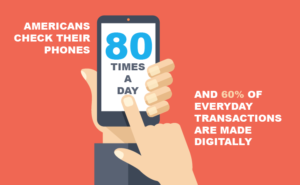July 2, 2018
New Impactful RCM Technology that Doesn’t Require Heavy IT Lifting

Your patients, every single one of them, are out there every day, living lives that have nothing to do with being patients — and they love it.
The second they step into most healthcare environments, they’re jolted into patient status again — an experience that, if we’re being honest, can be a little unpleasant. Of course, a big part of that is the discomfort of medical procedures, but it’s also the drag of adapting to communication that doesn’t fit their lives as consumers.
Your patients go about their days, choosing digital communication over phone at every turn, but when they need to question or pay a hospital bill? Suddenly, they’re thrown back to 1995 and your patient financial experience goes right out the window.
Things don’t have to be this way. You’ve got more options than you probably realize in aligning your communications with your patients’ preferences and giving them a few more reasons to choose you over the hospital down the street.
Embrace the Flow of the Patient Financial Experience
First off, payment communications aren’t siloed in their own world. When your patients are interrupting their busy days to call in and ask a question about a bill or make a payment arrangement, they consider it part of their entire experience with you. As a matter of fact, it’s often their first and last impression.
Respect the flow of your revenue cycle and ground that respect in your patients’ preferences. For example:
- According to Mary Meeker’s 2018 Internet Trends Report, 60 percent of everyday transactions were made digitally.
- Millennials in particular have moved past phone conversations and overwhelmingly prefer digital communication.
- Nine out of 10 consumers want to pay their healthcare bills online.
Your patients are obviously moving away from phone calls, but to really get the most out of your revenue cycle communications, you’ll need to understand the preferences of your specific patient mix. Simple surveys and observations of patient behavior can be effective. For example, we conducted a survey and found that 28 percent of portal payments are made outside of traditional 8-to-5 business hours. Also consider leveraging features of your existing technology (e.g. if you have an advanced CRM system or back-end data and analytics solution in place that can track patient behavior).
Evaluate Your IT-Friendly Tech Options
Once you have an idea of how the flow of your patient experience should be designed, you can start evaluating some interesting tech solutions. If that has you bracing for a drain on your IT staff, feel free to relax. We’re going to focus on simple changes you can make to meet all your patients’ expectations and keep payments on track.
Live Chat
You probably run into these all the time. They’re the little boxes that pop up at the bottom of a website asking if you need any assistance. Your patients are just as familiar with them, and if you want to jump on board, they’re generally simple to get up and running. The biggest bonus is that once you can gauge patient reactions you can reallocate staff to cover responses if needed.
SMS/Mobile Outreach
 Americans check their phones 80 times a day, and that number only increases as we look at more recent generations. If you can get in front of them on their smartphones, you can simplify their experience, drive patient payments, and strengthen your relationship overall.
Americans check their phones 80 times a day, and that number only increases as we look at more recent generations. If you can get in front of them on their smartphones, you can simplify their experience, drive patient payments, and strengthen your relationship overall.
SMS options open up a world of convenience to patients to access estimates as well as make payments. Building this type of solution in-house is likely to be a drain, but you’ll find multiple outsourcing solutions that will not only handle the heavy lifting, but can also give you more peace of mind around security challenges.
Email
Email might be old school, but the technology has seen some fascinating advancements in recent years. For example, it can be especially powerful when it’s mobile responsive and paired with text. The AJMC has even linked email with better outcomes and reduced costs. So what does that mean for your facility? Encourage your staff and providers to stay on top of email and use the advanced features they already have. You might even want to consider establishing best practices for email communication at your facility.
Optimized Portals
Your patient portal probably has the ability to do quite a bit of heavy lifting, but how well is it doing its job? A 2014 report from Software Advice on patient portal preferences revealed that patients’ most common complaints about portals were “confusing interface” (41 percent) and “unresponsive staff” (37 percent).
If your portal isn’t meeting expectations, consider simplification. Focus on patient favorites like online scheduling, viewing health information, paying bills, and filling out forms. Also consider a dedicated customer service representative portal and make sure someone at your facility is responsible for keeping responses timely.
The great thing about RCM technology is that getting more isn’t always about investing tons of staff time or even huge financial outlays. Sometimes it just comes down to listening to your patients and tweaking what you already have to fit what they already prefer.
RevSpring Can Help
Innovative integrated payment communication is part of RevSpring’s DNA. We tailor the payment conversation to influence behavior and inspire action. Our segmentation rules and workflows help you become hyper-focused on the patient, understanding the patient’s ability to pay and mapping his or her financial obligations to repayment pathways.
If you’d like to learn more about our comprehensive patient engagement and billing solutions, we’d love to help you. Request a demo to see how we can help your organization meet its goals.